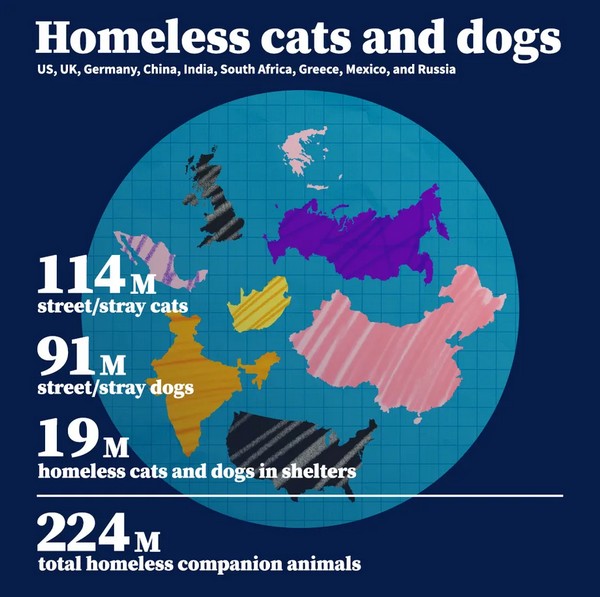Nothing brings joy to a home quite like a pet — and in an ideal world, all pets would live in loving homes. All dogs would have beds to snooze on and parks to play in. All cats would have laps to curl up in and toys to bat around the living room. After all, don't they deserve it for the endless cuddles, slobbery kisses, and getting us out of the house (and out of our heads)?
One look at rescue accounts on social media, though, and it's clear this is far from the reality today. Worldwide, pet homelessness is a persistent, complex issue, with hundreds of millions of stray cats and dogs living on the streets or in shelters.
Some of these animals may find homes through adoption. Jill Hilbrenner, Vox Creative's executive editor, welcomed her second rescue pup earlier this year, and says she can't imagine getting through the pandemic without Suzy Lee and Blanche.
'Having a dog — and now having dogs, plural — is grounding,' she says. 'When I feel my chest clenching from worry, I can look at my dogs, and it helps that melt away. I'm not saying skip the therapist, but I am saying dogs are great medicine.' That said, she adds, 'It breaks my heart thinking about what they had to go through before we met.'
Where we stand today
Even with so many prospective owners willing to rescue — and with dog and cat ownership on the rise in countries like China and India — we have a long way to go.
But how far, and how can we get there? Mars Petcare took on a first-of-its-kind initiative to answer these questions by measuring the global scale of cat and dog homelessness and helping to identify the root causes. Created with a panel of animal welfare experts and organizations, the State of Pet Homelessness Index analyzes data from 200 global and local sources to quantify the issue and help identify its underlying causes at a country-specific level. The initial phase evaluates nine countries on their care for, acceptance of, policies to support, and cultural attitudes towards pets to help provide a crucial benchmark to measure progress.
In the UK, for example, data show strong legislation protecting animals against cruelty brings the Index score up, but show it's pulled down by a lack of pet-friendly housing. While in India, data show most people report a positive experience owning a cat or dog, but a high prevalence of strays and a low sterilization rate represent significant obstacles to tackling pet homelessness.
The past tells us that progress is possible, though. In the 1970s, the US was euthanizing 13.5 million homeless dogs and cats yearly; today, that's down to about a million annually, even as the country's pet dog and cat populations have more than doubled.
'There's been a huge improvement in the way [animal welfare organizations are] seeing this particular challenge,' says Andrew Rowan, president of WellBeing International and one of the Index experts. 'And so the question is: how much better can we do, and how do we get there?'
Addressing a global issue
According to Index data, 224 million homeless cats and dogs live in the US, UK, Germany, China, India, South Africa, Greece, Mexico, and Russia. Of those, 114 million are stray cats, 91 million are stray dogs, and 19 million are cats and dogs in shelters.
At the start of the Index project, Mars Petcare's Advisory Board began with one fundamental question: What does the word 'homeless' mean for pets? Homelessness looks very different from one country to the next, so a one-size solution is unlikely.

In some regions, says Rowan, it's common for dogs and cats to get food and shelter from the community, but that stops short of veterinary care. Sterilization is often credited with reducing the number of US dogs and cats euthanized, but a similar initiative in India would mean sterilizing 30 to 50 million female dogs — a massive undertaking that won't happen overnight. Once pet homelessness is defined, the data show a localized approach is needed.
Why measure pet homelessness?
Science tells us that both humans and pets benefit from the other's companionship. For humans, research shows pet ownership can have positive physical and mental health impacts by reducing stress, lowering blood pressure, and helping prevent heart disease, among other illnesses. Dogs can also experience spikes in oxytocin — a neurochemical closely associated with trust, love, and social bonding — during positive interactions with their owners. Dogs have evolved over generations to be largely reliant on humans for food, shelter, and care, and without sustained care they're more susceptible to disease, malnutrition, and accidents.
'Across our family of veterinary businesses, our Associates have seen the problem of pet homelessness around the world and have worked to provide care and support for these animals,' says Jen Welser, Mars Veterinary Health's chief medical officer. 'We've implemented a wide range of programs on responsible pet-ownership education, improving access to veterinary care, and shelter support.' Until now, Welser notes, there was no way to reliably evaluate such a multifaceted issue, and no clear way to measure programs' impacts.
The housing dilemma
Many pet owners (especially those in big cities) know the challenge of finding pet-friendly housing. Policies that ban or restrict animals can deter many people from adopting pets or even drive owners to relinquish pets they have.
According to Index research, more than half of prospective owners said it's hard to find a rental that allows dogs, and 1 in 4 agreed it was difficult to find one permitting cats.
'There's a mantra, especially in the United States, that there are too many animals and not enough homes,' says Ellen Jefferson, president and CEO of Austin Pets Alive! and American Pets Alive! 'And the reality is there are enough homes, but if a lot of those homes are not inclusive of the pet part of the family, then that is driving shelter intake and driving animals to be euthanized in shelters.' With more data and awareness, she says, lawmakers and landlords can take steps to address this issue.
Creating care for all
Improving access to quality veterinary care is also essential. According to the Index data, one in three pet owners avoid the vet because of cost concerns. With more education and support, owners could be better prepared for costs when they arise.
'If we can really hone in on providing that support, think about the dramatic decrease in shelter intake that would happen,' says Jefferson. Plus, this support doesn't just help pets — it also helps the people that love them.
Before adopting, Hilbrenner studied up on caring for rescues — 'how to appear non-confrontational, how to read dog body language' — and over time, she says, both dogs have gained confidence. Still, it's an ongoing process.
'I like to think we're teaching each other to be more trusting and to spend less time in fight-or-flight stress mode,' she says. People thrive with pets, and pets thrive with people — and with the help of the Index, a world where both have access to the support they need is in sight.
'For the first time, we have insights into which factors are influencing the issue most in each country. This means we can lean into the most impactful ways to make a difference to help deliver on our purpose: 'A BETTER WORLD FOR PETS,'' says Mars Petcare's Welser. 'Our aim is that we — along with animal-welfare organizations, policymakers, pet professionals, academics, and researchers — can use this tool as a reference point that will better equip us all as we work to help end pet homelessness together.'
by Hilary George-Parkin - Mars Pet Care
You could be interested: Can Feeding Your Dog Once Daily Benefit their Health?






































